The Print on Demand Software Market is estimated to be valued at USD 4.5 billion in 2025 and is projected to reach USD 67.6 billion by 2035, registering a compound annual growth rate (CAGR) of 31.1% over the forecast period.
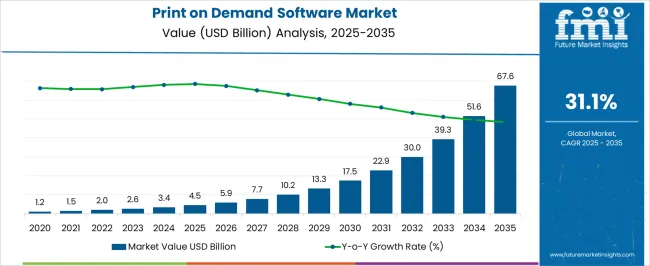
| Metric | Value |
|---|---|
| Print on Demand Software Market Estimated Value in (2025 E) | USD 4.5 billion |
| Print on Demand Software Market Forecast Value in (2035 F) | USD 67.6 billion |
| Forecast CAGR (2025 to 2035) | 31.1% |
The print on demand software market is undergoing rapid evolution as e-commerce and personalized merchandise trends continue to scale globally. Businesses are increasingly adopting centralized platforms that manage order fulfillment, product customization, and shipping integration in real time. The ability to automate design-to-print workflows, reduce inventory risks, and respond dynamically to consumer preferences is driving demand for advanced software ecosystems.
Integration with leading marketplaces and storefronts has enabled real-time sync of product catalogs, customer orders, and logistics updates. As digital printing technology becomes more cost-efficient and accessible, software vendors are embedding AI for mockup generation, sales analytics, and predictive inventory control.
Brands across apparel, home décor, and publishing are investing in robust platforms that can scale with increasing order complexity and volume. The continued rise of creators, microbrands, and DTC retail models is expected to sustain long-term adoption, especially in regions with high digital penetration and entrepreneurial growth.
The market is segmented by Type and Application and region. By Type, the market is divided into Integrated and Independent. In terms of Application, the market is classified into Businesses and Individuals. Regionally, the market is classified into North America, Latin America, Western Europe, Eastern Europe, Balkan & Baltic Countries, Russia & Belarus, Central Asia, East Asia, South Asia & Pacific, and the Middle East & Africa.
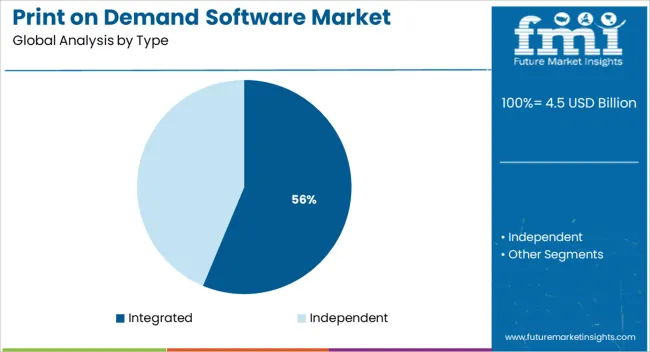
The integrated type segment is projected to hold 56.3% of total market revenue in 2025, making it the leading software type. This position has been established by the growing preference for platforms that combine storefront integration, design tools, inventory sync, and order management within a single ecosystem.
Businesses have prioritized seamless operation and reduced manual intervention, which has positioned integrated platforms as the foundation for scalable and automated print on demand operations. The integration of third-party logistics providers, automated shipping updates, and one-click store setups has reinforced trust among SMEs and enterprise clients alike.
Additionally, the ability to centralize multi-channel fulfillment has minimized operational friction and enabled quicker go-to-market execution, consolidating integrated platforms as the preferred software type in this space.
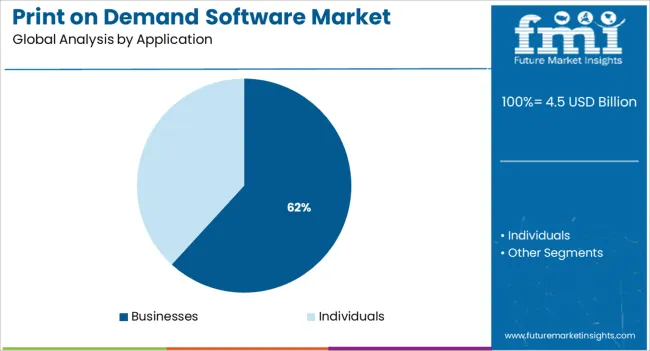
The businesses segment is anticipated to contribute 61.8% of total market revenue by 2025 under the application category, leading the overall market. Its growth has been driven by widespread enterprise digitalization, the rise of global e-commerce, and increasing demand for custom merchandise at scale.
Businesses ranging from large retailers to niche brands are leveraging print on demand software to eliminate inventory holding costs while offering personalized products in real time. These platforms have become essential for campaign-based sales, event merchandise, seasonal collections, and influencer collaborations.
The integration of API-based design libraries, automated billing systems, and fulfillment tracking has made them indispensable for commercial users. Strategic investments in branded customer experiences and backend automation have further reinforced the dominance of business-centric applications within the print on demand software market.
As per the Print-on-demand Software market research by Future market insights - a market research and competitive intelligence provider, historically, from 2020 to 2024, the market value of Print-on-demand Software increased at around 34.9% CAGR, wherein, countries such as the USA, China, Japan, UK, and South Korea held a significant share in the global market. With an absolute dollar opportunity of USD 4.5 Billion during 2025 to 2035, the market is expected to reach a valuation of USD 67.6 Billion by 2035.
Print-on-demand benefits include items sold with one’s own image name connected or tweaked and imprinted on the things they sold through their site. With print-on-demand deals, one does not pay for a product until the demand is set and the outsider provider prints it.
After the client submits a demand, the print-on-demand provider will deal with everything starting there on, from printing administrations to delivery. Print-on-demand is a type of outsourcing model. In any case, Print-on-demand and altogether outsourcing vary in that with Print-on-demand, things are only printed and delivered once every individual demand comes in.
Print-on-demand can be depicted as white-mark outsourcing. It gives a method for putting one’s logo and especially crafts on clothing, extras, and different items when every client submits a demand. Outsourcing organizations and their outsourcing models have items loaded and all set when it is the ideal opportunity for them to be sent out the entryway. When an outsourcing organization is reached with demand, the outsourcing substance will track down it in the distribution center, bundle it up, and transport it out to the client.
Print-on-demand software is a structure for overseeing and enhancing printing machines and systems in a precise and ideal way. Ventures might utilize print control software to unify the administration of printing hardware. Similarly, it likewise helps organizations in bringing down printing costs by permitting them to follow, make due, and work their whole printer armada from a solitary application interface.
Print the board software likewise considers mailing and conveyance, as well as quick and counterbalanced printing. Since this product takes into consideration bound together to control, it can likewise be utilized to deal with copiers, scanners, and work area printers. Print the executive’s software is accessible as an independent software and as a component of overseen print offices as installed usefulness. The market for print the demand software is to a significant extent driven by the increasing expense of sheets, printers, toner, and ink for organizations from one country to the other.
Print-on-demand is an elective method for saving time and speculation as well as keeping away from the monotonous course of stock administration. Therefore, one can channel their inventiveness and basically sell their custom items for a portion of the expense. Most Print-on-demand stages are simple and easy to utilize. It is generally a straightforward course of joining, making a profile, and transferring their plans or items.
The print-on-demand model disposes of the greatest drawback of stock-based inconveniences like stock expenses, and costs, among others. It likewise wipes out the chance of stalling out with additional products that one cannot sell or stock-outs on the grounds that the product goes into formation after a demand is raised.
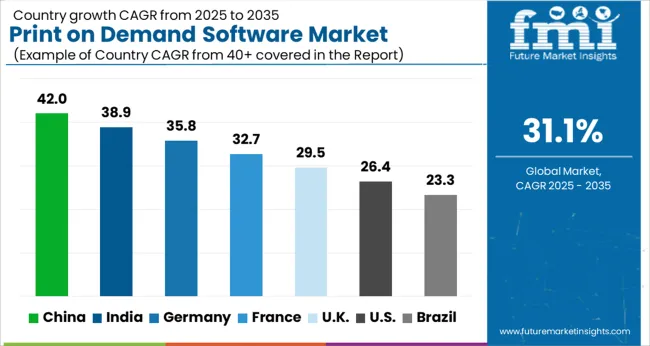
The USA dominated the global Print-on-Demand Software Market in 2024 is expected to register a CAGR of 30.8% during 2025 to 2035. The market in the USA is likely to exceed a valuation of USD 67.6 Billion by 2035. This can be credited to the presence of large number of print-on-demand players in the country.
Furthermore, innovation and assembling foundation in the country are likewise driving business sector development. The reason of this dominance is, Print-on-demand software is a structure for overseeing and upgrading printing machines and methods in an exact and ideal way. Ventures might utilize print control software to incorporate the administration of printing gear. It likewise helps organizations in bringing down printing costs by permitting them to follow and work their whole printer fleet from a solitary application interface. Print management software additionally takes into consideration mailing and conveyance, as well as quick and balanced printing. Since this product takes into consideration brought together to control, it can likewise be utilized to deal with copiers, scanners, and work area printers.
The Integrated segment held the largest market share with a CAGR of 29.8% contributing significantly to the growth of the global Print-on-demand Software market. The development of this segment can be credited to elements like speedy setup, cost-effectiveness, and adaptability. Moreover, the global market is expected to grow due to the rising interest for constant information on printer armadas, as well as fruitful administration and advancement of the printing system by organizations utilizing Print-on-demand software. Besides, organizations and legislatures are expected to put a more noteworthy spotlight on natural protection and paper disposal, as would be considered normal to fuel the reception of Print-on-demand software.
The expense of products for an on-demand printing administration will be higher when contrasted with purchasing discount. This implies that net revenues will be lower. Since the print on request organizations handle the entire of the delivery, bundling, and selling, they will take a larger level of the benefit, and pay a commission for the item being sold.
Craftsmen can either be paid through a rate on every deal that is through sovereignties, or markup from the primary concern cost of the item, where the craftsman can decide to conclude the retail cost. Thus, contingent upon the item, the overall revenue can be very low. Unit organizations work with various providers to source items or item materials, for instance, texture. This implies there are several deals of moving parts, and in some cases, items might leave stock or become inaccessible.
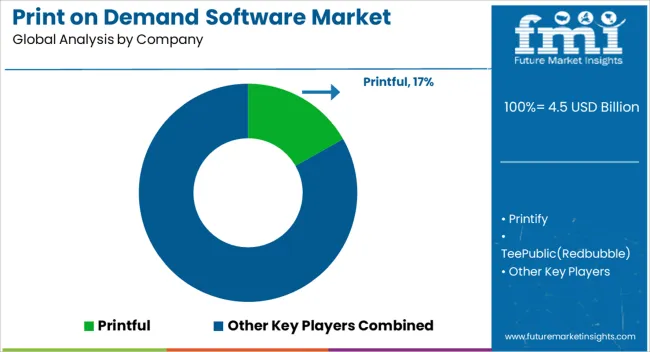
The Print-on-Demand market is highly competitive where the key players include Amplifier, Apliiq, CustomCat, Gelato, Gooten, JetPrint, Printed Mint, Printful, Inc., Printify, Inc., Printsome, Prodigi Group, Redbubble Group, T-Pop, Teelaunch, VistaPrint, and Zazzle Inc.
Some of the key recent developments in the print-on-demand software market are as follows:
Similarly, recent developments related to companies offering Print-on-Demand Software have been tracked by the team at Future Market Insights, which are available in the full report.
The global print on demand software market is estimated to be valued at USD 4.5 billion in 2025.
The market size for the print on demand software market is projected to reach USD 67.6 billion by 2035.
The print on demand software market is expected to grow at a 31.1% CAGR between 2025 and 2035.
The key product types in print on demand software market are integrated and independent.
In terms of application, businesses segment to command 61.8% share in the print on demand software market in 2025.






Our Research Products

The "Full Research Suite" delivers actionable market intel, deep dives on markets or technologies, so clients act faster, cut risk, and unlock growth.

The Leaderboard benchmarks and ranks top vendors, classifying them as Established Leaders, Leading Challengers, or Disruptors & Challengers.

Locates where complements amplify value and substitutes erode it, forecasting net impact by horizon

We deliver granular, decision-grade intel: market sizing, 5-year forecasts, pricing, adoption, usage, revenue, and operational KPIs—plus competitor tracking, regulation, and value chains—across 60 countries broadly.

Spot the shifts before they hit your P&L. We track inflection points, adoption curves, pricing moves, and ecosystem plays to show where demand is heading, why it is changing, and what to do next across high-growth markets and disruptive tech

Real-time reads of user behavior. We track shifting priorities, perceptions of today’s and next-gen services, and provider experience, then pace how fast tech moves from trial to adoption, blending buyer, consumer, and channel inputs with social signals (#WhySwitch, #UX).

Partner with our analyst team to build a custom report designed around your business priorities. From analysing market trends to assessing competitors or crafting bespoke datasets, we tailor insights to your needs.
Supplier Intelligence
Discovery & Profiling
Capacity & Footprint
Performance & Risk
Compliance & Governance
Commercial Readiness
Who Supplies Whom
Scorecards & Shortlists
Playbooks & Docs
Category Intelligence
Definition & Scope
Demand & Use Cases
Cost Drivers
Market Structure
Supply Chain Map
Trade & Policy
Operating Norms
Deliverables
Buyer Intelligence
Account Basics
Spend & Scope
Procurement Model
Vendor Requirements
Terms & Policies
Entry Strategy
Pain Points & Triggers
Outputs
Pricing Analysis
Benchmarks
Trends
Should-Cost
Indexation
Landed Cost
Commercial Terms
Deliverables
Brand Analysis
Positioning & Value Prop
Share & Presence
Customer Evidence
Go-to-Market
Digital & Reputation
Compliance & Trust
KPIs & Gaps
Outputs
Full Research Suite comprises of:
Market outlook & trends analysis
Interviews & case studies
Strategic recommendations
Vendor profiles & capabilities analysis
5-year forecasts
8 regions and 60+ country-level data splits
Market segment data splits
12 months of continuous data updates
DELIVERED AS:
PDF EXCEL ONLINE
Printing Paper Market Size and Share Forecast Outlook 2025 to 2035
Printed Labels Market Size and Share Forecast Outlook 2025 to 2035
Printed Sensors Market Size and Share Forecast Outlook 2025 to 2035
Printing Machinery Market Size and Share Forecast Outlook 2025 to 2035
Printed Circuit Board (PCB) Assembly Market Size and Share Forecast Outlook 2025 to 2035
Printer Market Size and Share Forecast Outlook 2025 to 2035
Printed Tape Market Size and Share Forecast Outlook 2025 to 2035
Printed Antenna Market Size and Share Forecast Outlook 2025 to 2035
Printed Aluminium Foil Packaging Market Size and Share Forecast Outlook 2025 to 2035
Printed and Flexible Sensors Market Report - Growth & Demand 2025 to 2035
Printed Circuit Boards (PCB) Market Trends - Demand & Forecast 2025 to 2035
Printed Plastic Films Market Insights - Growth & Forecast 2025 to 2035
Printed Boxes Market Analysis – Trends, Demand & Forecast 2025 to 2035
Printing Supplies Market Analysis by Application, Technology, and Region Forecast Through 2035
Industry Share & Competitive Positioning in Printed Aluminium Foil Packaging
Printing Plate Market
Printable Tags Market
Print & Apply Corner Wrap Labelling System Market
Print On Demand Market Size and Share Forecast Outlook 2025 to 2035
Printing Toners Market Size and Share Forecast Outlook 2025 to 2035

Thank you!
You will receive an email from our Business Development Manager. Please be sure to check your SPAM/JUNK folder too.
Chat With
MaRIA